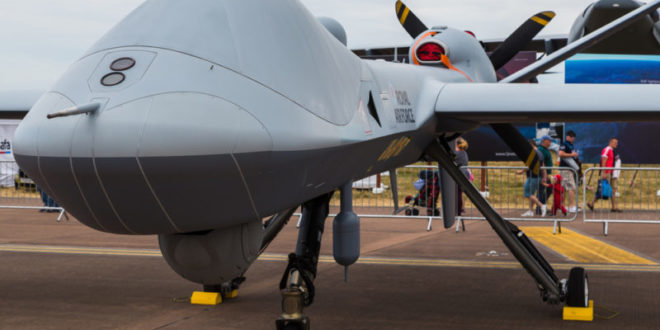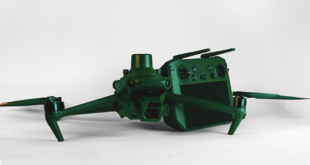In 2014, a U.S. Customs and Border Protection drone experiencing a mechanical failure was deliberately drowned in the ocean off San Diego.
The unmanned aircraft didn’t have enough battery to go all the way back to Arizona, so the ground crew steering it chose the water as the safest recovery site. But for approximately two minutes, the pilot lost contact. By the time the drone crashed, it was headed back in the direction of Point Loma.
The federal agents who recovered the wreckage suffered minor injuries due to inhalation and exposure to jet fuel and lacerations from handling carbon fiber shards without proper equipment.
In the nine months leading up to the San Diego crash, according to a subsequent CBP report, similar drones produced by the same local defense contractor, General Atomics, failed 18 times due to problems with the starter-generator.
The company is now developing a new military-grade drone, known as the SkyGuardian, with plans to market the unmanned aircrafts to police and other emergency responders as well as public planners. But first the company needs to prove that the device is safe to put above a densely populated metro — and it’s chosen San Diego as the prospective test site.
The Federal Aviation Administration is responsible for granting that permission, but it has declined to say more about the process and is dragging its feet on internal records that might show how regulators are thinking about the SkyGuardian in light of past drone crashes.
That’s why Voice of San Diego is suing the public agency.
If the SkyGuardian, which spans 79 feet across its wings and weighs up to 12,500 pounds, successfully flies above the city, it will set major precedent in the United States. It will literally open civilian airspace to new commercial uses and new forms of surveillance — what the company itself has dubbed a “persistent eye in the sky.”
Yet there’s still a lot the public doesn’t know about the project.
For months, I’ve been trying to understand whether regulators are satisfied that the technologies on board the SkyGuardian — which allow it, among other things, to automatically detect and avoid collisions with other aircraft — are safe to put above the heads of San Diegans. I’ve also been trying to figure out who’s backing the test flight and why.
Last year, General Atomics announced that San Diego was supportive of the project. But in March, Jose Ysea, a spokesman for the mayor, said the city’s drone program was not working with the company on the SkyGuardian. General Atomics also announced last year that a test flight was scheduled for 2020 — one industry report said summer —but a date hasn’t been set yet and the cause of the hold-up is unclear.
“We can’t get into details about a military aircraft program,” wrote Marcia Alexander-Adams, a public affairs manager for the FAA, in an email. “The FAA is working closely with the manufacturer to ensure the aircraft operates safely in civilian airspace.”
In a complaint filed Friday, VOSD alleged that the FAA is improperly withholding public records initially requested in March about the SkyGuardian flight in violation of the Freedom of Information Act. The law gives the public the right to access certain documents in possession of the U.S. government. By law, those documents are supposed to be released in either full or partial form within a few weeks of a request.
The complaint also names the Federal Communications Commission and makes similar allegations. Earlier this year, the FCC appears to have granted the company an experimental license to fly a drone in the deserts between California and Arizona.
“VOSD believes that access to the records that it seeks from the FCC and the FAA about this drone program are essential to its readers and the public’s understanding of this program before the flight takes place as early as this summer,” Thomas Burke of Davis Wright Tremaine, who is representing Voice of San Diego, wrote in the filing. “There is particular public interest in this flight, not just because it is unprecedented and will open up civilian airspace, but because drone crashes are fairly common.”
In an email, Steven Henden, a General Atomics spokesman, told me the desert test flight that took place earlier this year was intended to show how the SkyGuardian could be used commercially and for public good — by inspecting things like power lines and canals, and monitoring flooding and wildfires. He called it “a robust aircraft, capable of flying for more than 40 hours,” and said it would need to meet the same standards in the sky as manned aircraft.
So far, the company has been more open about where it is in the regulatory process than the nation’s actual aviation regulators. Henden confirmed that General Atomics still had an open application with the FAA to certify that its drone technology is safe.
“This will take some time,” he said.
FOIA Lawsuits Are More and More Common
FOIA lawsuits are an increasingly common way for journalists to gain access to records that the U.S. government should willingly provide under the law. One of the problems is that FOIA requests can take years to complete. And by the time the documents arrive — assuming they arrive at all — the information may no longer be relevant or newsworthy.
In 2017, Voice of San Diego’s Maya Srikrishnan asked the Army Corps of Engineers for documents related to border infrastructure proposals in San Diego and Imperial counties. Any project was likely to impact the health and economic well-being of residents.
Nearly 11 months went by without a response, so we sued to enforce the law. The court took our side, but the documents weren’t completely in our possession until May 2019. By then, parts of the border project were already completed and others were well underway.
When asked to explain the time delays, federal agencies will typically cite a lack of resources and a backlog of requests. That may well be the case. But that’s also why litigation is necessary. It pushes one’s request toward the top.
During former President Barack Obama’s second term, the number of media-led FOIA lawsuits jumped 35 percent. The FOIA Project, a Syracuse University-connected group that tracks these cases, noted in 2017 that there’d been a rise of individual reporters willing to file lawsuits.
Despite the transparency it’s brought to government, FOIA is nevertheless a flawed law because it gives agencies significant say over what is and isn’t in the public interest. Federal employees are not just applying the law but interpreting it on their own.
David McCraw, deputy general counsel at The New York Times, has also argued that the deadlines imposed on federal agencies to produce records, as mandated by Congress, have been robbed of meaning by the courts. Federal agencies are supposed to respond within 20 business days. Anyone who’s been denied can appeal to the head of an agency and usually has 90 days to mount that defense.
The documents are rarely released that quickly. And when people complain in court, judges tend to be sympathetic to the federal agencies that say they’re overwhelmed by the high number of requests they receive. One of FOIA’s more admirable principles — the right of anyone to know what their government is doing — has been used against itself.
The SkyGuardian Test Is Bigger Than San Diego
The FAA’s stamp of approval will go a long way toward legitimizing the SkyGuardian and its technologies. But press reports suggest that, when it comes to drones, the regulatory process is not free of political pressure.
In 2018, military leaders in England pushed their country’s regulators to give the public only a few days’ warning about a General Atomics’ drone test to avoid protests, the Guardian and Tech Crunch reported. It was the first time a drone would leave the United States and make the transatlantic journey through British civilian airspace. One aviation regulator in an email urged colleagues to “tread really carefully on this one” and not roll over for military leaders who wanted to see the project happen.
Their questions were basic: How would the drone know where it was, and how would the crew controlling it from miles away stay in perpetual control?
But they also seemed confused how the transatlantic flight would begin in North Dakota because at the time FAA rules prohibited such drones from flying over most densely populated areas in the United States. They also seemed to be looking at their American counterparts for more guidance.
“If General Atomics can’t get the FAA to back up the safety of the aircraft, then why should we be letting it into our airspace?” one British regulator wondered in an email.
Eventually, the FAA relaxed its rules and cleared the way for the transatlantic flight, which could in turn clear the way for the test flight in San Diego.
How the FAA is thinking about the SkyGuardian project in light of the transatlantic flight and the mechanical failures of 2013 and 2014 is unclear. But we’re not the only ones frustrated by the lack of openness.
A Government Accountability Office report released in January considered the FAA’s role in further integrating drones into the American economy and society. The FAA maintains test sites for public and private interests, and the study criticized the agency for reporting “limited public information” related to the research being developed there.
Agency officials told the GAO that they were wary of sharing proprietary information. But most of the people who work on those sites said it would be helpful to know more about one another’s research efforts.
In other words, everyone with an eye on the drone industry would like to know where it’s headed and how.
 Unmanned Aerial Vehicle The latest drone news
Unmanned Aerial Vehicle The latest drone news





